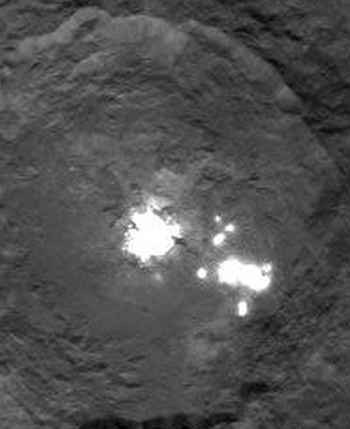New close-up image of Ceres’s double bright spots

Cool image time! The Dawn science team has released a some new close-up images of Ceres, including a much higher resolution image of the dwarf planet’s double bright spot, which now resolves itself into a cluster of two larger spots with a half dozen smaller spots scattered nearby.
The region with the brightest spots is in a crater about 55 miles (90 kilometers) across. The spots consist of many individual bright points of differing sizes, with a central cluster. So far, scientists have found no obvious explanation for their observed locations or brightness levels.
“The bright spots in this configuration make Ceres unique from anything we’ve seen before in the solar system. The science team is working to understand their source. Reflection from ice is the leading candidate in my mind, but the team continues to consider alternate possibilities, such as salt. With closer views from the new orbit and multiple view angles, we soon will be better able to determine the nature of this enigmatic phenomenon,” said Chris Russell, principal investigator for the Dawn mission based at the University of California, Los Angeles.
To my eye, these bright areas resemble a wide flat caldera of a volcano. Instead of being at the top of a peak, the caldera is like a lava pool, almost like a large lake. In this case, the large spots are lakes of frozen ice that periodically melt and flow. The smaller spots are likely smaller vents where water can bubble up from below during active periods. When not active, the water will be frozen. Since ice is white and Ceres is very dark, the pools and vents appear extremely bright in these images.
I am speculating however. We will have to wait for much better images to know for sure.
On Christmas Eve 1968 three Americans became the first humans to visit another world. What they did to celebrate was unexpected and profound, and will be remembered throughout all human history. Genesis: the Story of Apollo 8, Robert Zimmerman's classic history of humanity's first journey to another world, tells that story, and it is now available as both an ebook and an audiobook, both with a foreword by Valerie Anders and a new introduction by Robert Zimmerman.
The ebook is available everywhere for $5.99 (before discount) at amazon, or direct from my ebook publisher, ebookit. If you buy it from ebookit you don't support the big tech companies and the author gets a bigger cut much sooner.
The audiobook is also available at all these vendors, and is also free with a 30-day trial membership to Audible.
"Not simply about one mission, [Genesis] is also the history of America's quest for the moon... Zimmerman has done a masterful job of tying disparate events together into a solid account of one of America's greatest human triumphs."--San Antonio Express-News

Cool image time! The Dawn science team has released a some new close-up images of Ceres, including a much higher resolution image of the dwarf planet’s double bright spot, which now resolves itself into a cluster of two larger spots with a half dozen smaller spots scattered nearby.
The region with the brightest spots is in a crater about 55 miles (90 kilometers) across. The spots consist of many individual bright points of differing sizes, with a central cluster. So far, scientists have found no obvious explanation for their observed locations or brightness levels.
“The bright spots in this configuration make Ceres unique from anything we’ve seen before in the solar system. The science team is working to understand their source. Reflection from ice is the leading candidate in my mind, but the team continues to consider alternate possibilities, such as salt. With closer views from the new orbit and multiple view angles, we soon will be better able to determine the nature of this enigmatic phenomenon,” said Chris Russell, principal investigator for the Dawn mission based at the University of California, Los Angeles.
To my eye, these bright areas resemble a wide flat caldera of a volcano. Instead of being at the top of a peak, the caldera is like a lava pool, almost like a large lake. In this case, the large spots are lakes of frozen ice that periodically melt and flow. The smaller spots are likely smaller vents where water can bubble up from below during active periods. When not active, the water will be frozen. Since ice is white and Ceres is very dark, the pools and vents appear extremely bright in these images.
I am speculating however. We will have to wait for much better images to know for sure.
On Christmas Eve 1968 three Americans became the first humans to visit another world. What they did to celebrate was unexpected and profound, and will be remembered throughout all human history. Genesis: the Story of Apollo 8, Robert Zimmerman's classic history of humanity's first journey to another world, tells that story, and it is now available as both an ebook and an audiobook, both with a foreword by Valerie Anders and a new introduction by Robert Zimmerman.
The ebook is available everywhere for $5.99 (before discount) at amazon, or direct from my ebook publisher, ebookit. If you buy it from ebookit you don't support the big tech companies and the author gets a bigger cut much sooner.
The audiobook is also available at all these vendors, and is also free with a 30-day trial membership to Audible.
"Not simply about one mission, [Genesis] is also the history of America's quest for the moon... Zimmerman has done a masterful job of tying disparate events together into a solid account of one of America's greatest human triumphs."--San Antonio Express-News


How bright are they for real?
Is the dark surface “as dark as charcoal” and the “white” areas just slightly less dark that charcoal?
Less *THAN* charcoal
See this article. The important quote is this: